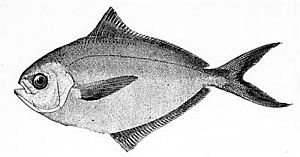American butterfish facts for kids
Quick facts for kids American butterfish |
|
|---|---|
 |
|
| Scientific classification | |
| Synonyms | |
|
The American butterfish (Peprilus triacanthus), also known as the Atlantic butterfish, is a small, flat fish. It belongs to the butterfish family, called Stromateidae. You can find this fish in the Atlantic Ocean.
Contents
What Does the American Butterfish Look Like?
These fish have a body that is quite deep and flattened from side to side. They often look somewhat round or circular. They have a blunt nose and a small mouth with weak teeth.
Some special features of the American butterfish include:
- They do not have ventral fins (fins on their belly).
- They have one long dorsal fin (the fin on their back).
- Their pectoral fins (fins on their sides, like arms) are long.
- They have tiny, smooth scales called cycloid scales.
- Their tail fin is deeply forked, almost as long as their dorsal fin.
The American butterfish looks a bit like its relative, the harvestfish (Peprilus alepidotus). However, you can tell them apart because the butterfish has much lower dorsal and tail fins.
The top of the American butterfish is a lead-blue color. Its sides are pale, and its belly is silvery. It often has dark, uneven spots on its body.
Most American butterfish are about 6 to 9 inches (15 to 23 cm) long. Some can grow up to 12 inches (30 cm). They usually weigh between 1.75 and 20 ounces (50 to 567 grams).
Where Do American Butterfish Live?
You can find American butterfish along the Atlantic coast of North America. They live from the waters off South Carolina all the way up to Nova Scotia and Cape Breton in Canada. Sometimes, they wander further north into the Gulf of St. Lawrence or to Newfoundland. They can also be found further south in Florida, but usually in deeper water there.
Even though the American butterfish is a common fish and an important food source, we still don't know a lot about it. These fish travel in small groups or loose schools. They prefer areas with sandy bottoms over muddy ones. They often come close to the shore.
During the summer, they usually stay in shallower waters, about 10 to 15 fathoms deep (which is about 20 to 30 meters). But in the winter and early spring, they move to much deeper waters. They can be found 100 to 115 fathoms (200 to 230 meters) below the surface.
What Do American Butterfish Eat?
The American butterfish eats a variety of small creatures. Their diet includes:
- Small fish
- Crustaceans (like tiny crabs or shrimp)
- Annelids (which are segmented worms)
How Do American Butterfish Have Babies?
American butterfish lay their eggs, a process called spawning, in the Gulf of Maine. This happens during the summer months, with the most activity in July. They seem to spawn a few miles out at sea. After they finish laying eggs, they return closer to the coast.
The eggs hatch very quickly. In water that is 65 °F (18 °C), the eggs hatch in less than 48 hours. When they first hatch, the baby fish, called "fry," are only about 2 millimeters long. By autumn, these young fish have grown to about 3 to 4 inches (7.5 to 10 cm) long. American butterfish usually become old enough to have their own babies when they are about two years old.
- Froese, Rainer and Pauly, Daniel, eds. (2006). "Peprilus triacanthus" in FishBase. January 2006 version.

